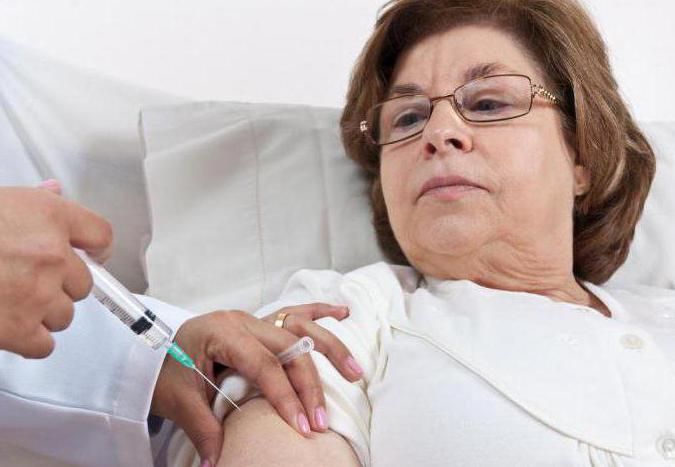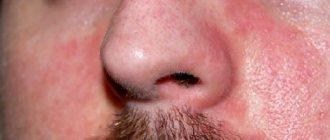Some medical procedures require local anesthesia. Quite often, doctors use Lidocaine for this purpose. The drug has earned recognition from specialists for its strong analgesic effect and long-lasting action. But it cannot always be used; an allergic reaction to Lidocaine is considered a significant contraindication.
The symptoms of a specific reaction to an anesthetic are not always weak. Sometimes the patient may develop anaphylactic shock. In this case, the patient will need urgent medical attention.
Causes of an allergic reaction to the drug
Lidocaine has a rather complex chemical composition. This multicomponent drug is used as an anesthetic and antiarrhythmic drug. Any of the components of the medicine can provoke the development of an allergic reaction. Very often the body's reaction is caused by a preservative (methylparaben).
Another reason for the development of an allergy to an anesthetic may be a genetic predisposition. More often, negative, adverse reactions occur due to the presence of the patient:
- mental dysfunctions;
- vegetative-vascular disorders of the nervous system.
It is important to distinguish between concepts such as intolerance to a drug and allergy to it. Doctors explain lidocaine intolerance by cardiotoxic, neurotoxic effects. To verify the presence of allergies, a special allergy test is performed.
Contraindications
Whether lidocaine is harmful depends on how correctly the product is used. The anesthetic drug has some contraindications, so this fact must be taken into account before use. Using the product without first consulting a doctor is unacceptable, as undesirable consequences may occur.
The drug should not be used if the patient has:
- individual intolerance;
- diseases of the brain or nervous system of an infectious nature;
- myasthenia gravis;
- bleeding;
- tumor in the brain.
This anesthetic has other contraindications, including:
- atrioventricular block (2nd and 3rd degrees);
- heart failure (2nd and 3rd degrees);
- severe bradycardia;
- severe renal failure;
- sick sinus syndrome;
- low pressure.
Lidocian is prescribed with extreme caution if the patient has a history of arrhythmia or other heart problems, blood clotting problems, or epilepsy. This anesthesia is also used very carefully in older people.
Since lidocaine cannot be used for many specific diseases, only a doctor can prescribe it after studying the condition of the body. The healthcare professional must consider many factors (such as age, heart and liver conditions) before prescribing this drug.
Signs of allergies
An allergic reaction to the anesthetic can manifest itself as dermatitis and urticaria. There may also be more complex reactions of the body in the form of rhinitis, edema, bronchial asthma, Quincke's edema, allergic vasculitis, anaphylactic shock.
How do you know that a patient is allergic to the anesthetic used? After all, a person may experience side effects after using the drug. To do this, you need to know the possible symptoms of an allergy to lidocaine. Let us consider the symptoms of a specific reaction of the body in more detail.
As an allergic reaction, the patient may experience the following pathological conditions:
- dermatitis (usually people experience peeling, itching, redness of the skin, and weeping);
- rhinoconjunctivitis (this pathology is accompanied by sneezing, mucus discharge from the nose, a feeling of the presence of a foreign body inside the eye, lacrimation);
- urticaria (itching, swelling, blisters in the mucous membranes and on the skin);
- bronchospasm (this condition is similar to an attack of bronchial asthma);
- Quincke's edema (doctors consider this condition to be an extreme manifestation of urticaria. The patient experiences severe swelling of the larynx, some parts of the body, lungs, and other organs);
- anaphylactic shock.

Typically, such conditions occur in people after an anesthetic is injected into the blood. In some cases, a delayed reaction is observed (signs of allergy begin to appear after several hours).
With dermatitis and urticaria, the following signs are usually recorded:
- unbearable itching;
- runny nose;
- conjunctivitis;
- swelling of the lower and upper lips;
- swelling of the larynx, cheeks.
At the same time, doctors record difficulty in swallowing and breathing. The most severe consequence of an allergy to the drug is considered to be cardiac arrest and the development of anaphylactic shock. But experts say that such consequences can only occur with an overdose of this anesthetic.
Drug intolerance can have a variety of symptoms. Initially, the patient is concerned about the deterioration of the condition in the form of:
- nausea;
- dizziness;
- vomiting.
Over time, other symptoms are added:
- apathy;
- drowsiness;
- visual impairment;
- weakness of breathing;
- blurred consciousness;
- arrhythmia;
- lowering blood pressure.
Mechanism of action
If the product is used intramuscularly, the effect appears within 7-10 minutes. If the drug is applied to the skin in the form of a spray, the effect should be expected after 25 minutes.
Initially, the drug enters the organs where good blood circulation is ensured. Such organs are the heart muscle, lungs, and brain.
When administered by infusion, the drug very easily passes into breast milk, as well as through the placenta. If lidocaine is used by persons who have chronic kidney failure, the drug may accumulate.
Features of allergies in a child
In children, allergies to lidocaine manifest themselves in different ways. It all depends on the immune system. The first contact with the anesthetic can occur without any abnormalities. But the next interaction with Lidocaine can cause an allergic reaction. For this reason, an allergy test for allergies must be done before the treatment procedure.
When the test result is positive, Sevoran can be used as an anesthetic. This drug is used for induction and maintenance of local anesthesia. This anesthesia is performed by inhalation. Therefore, a person quickly loses consciousness and quickly comes to his senses. This anesthesia is more expensive than usual, but this cost is justified by its effectiveness. The child can perform any treatment procedure painlessly.
Aerosol Applications
In surgical practice, lidocaine is used to block nerve fibers and nodules. In ophthalmic practice, the product is used to provide an analgesic effect during eye manipulation.
If a person needs local anesthesia, an aerosol is used:
- During tingling of the maxillary sinuses, rinsing.
- When removing nasal polyps.
- In case of opening of a paratonsillar abscess.
- When performing adenomotomy, tonsillectomy.
The injection is often given by the dentist when treating teeth. Lidocaine is required if a gastroduodenal tube is inserted. Treatment with the drug is also carried out by gynecologists in the case of various manipulations with the cervix. Some doctors use anesthesia during a serious suppurative process, as well as before rectoscopy, if it is necessary to remove sutures.
It is used intravenously and intramuscularly in the following cases:
- For flutter, tachyarrhythmia, fibrillation.
- With spinal lesions.
- In the form of eye drops to relieve the patient of discomfort.
- Surgeons block nerve fibers and nodes with lidocaine.
Diagnosis of a specific reaction to lidocaine
Before administering local anesthesia for the upcoming treatment, the doctor must determine whether the patient is allergic to lidocaine. Before any procedure that involves pain relief, the doctor interviews the patient for any allergies in the past or any reaction to medications. If there have been specific reactions to medications in the past, the doctor assesses the risks and possible harm of Lidocaine. He will need to examine the patient to detect sensitization of the body.
To check for allergies to anesthetics, specialists have developed special allergy tests for lidocaine. This method allows you to quickly assess the hypersensitivity of the body and accurately determine the immunological status.
How is the sample made? The drug (0.1 ml Lidocaine) is injected intradermally from the inner surface of the forearm. The test is negative if a local, general reaction does not appear at the injection site after 20 minutes.

The allergy test drug contains adrenaline. This substance is necessary in order to prevent vasoconstriction, in which the main substance is less absorbed. After all, insufficient absorption of Lidocaine can show a false negative reaction.
An allergy test can also be carried out in another way. Scratches are made on the forearm with the tip of a needle. Lidocaine is dripped onto the wounds. The norm is the absence of such manifestations:
- inflammation;
- burning;
- rash.
Doctors do not consider the skin test to be absolutely accurate. To accurately diagnose an allergy to Lidocaine, you need to donate blood for an ELISA test for the drug. A mast cell destruction reaction (MCD) is also performed. Children can take allergy tests from the age of five (with parental consent).
First aid for allergies
If the patient develops any signs of a specific reaction to the drug, you must stop administering the medicine and provide first aid. Unpleasant sensations after administration of the drug cannot be tolerated. It is imperative to indicate their manifestation to the doctor and medical staff. Indeed, in emergency situations it is very difficult to distinguish side effects from anaphylactic shock (due to the similarity of the vasomotor reaction).
The first actions of doctors are aimed at limiting the entry of anesthetic into the blood, stabilizing blood pressure, and normalizing vascular tone. The algorithm of actions when a reaction occurs looks like this:
- Applying a tourniquet, a tight pressure bandage above the area where the anesthetic is administered.
- Cooling the injection area.
- Injection with adrenaline (dosage is calculated taking into account age).
- Give antihistamines (Tavegil, Suprastin are administered intramuscularly).
After specific symptoms are relieved, the patient is hospitalized for several days.
Symptoms
In case of poisoning, symptoms of depression of the heart muscle and nervous system occur. Over time, the symptoms only increase.
If such symptoms occur, the person urgently needs to be taken to the hospital.
If you do not calculate the dose, such unpleasant signs will appear - depression of the nervous system, disruption of the heart, and a gradual increase in heaviness in it. Pay attention to these body signals:
- It seems to a person that goosebumps are crawling all over him.
- The skin turns pale.
- Sweating increases.
- Weakness appears.
- The tongue becomes very numb.
- Excited or, on the contrary, inhibited state.
- I feel very dizzy.
- The pressure drops.
- Tremor in the limbs.
Treatment of allergies to anesthetic
If an allergy to Lidocaine manifests itself at home, you can remove its signs in the following ways:
- If signs of urticaria or dermatitis appear, it is recommended to take a cold shower and apply a cold compress to the area of the rash. These measures help eliminate severe itching and redness. To reduce itching, you can apply sunburn ointment. You need to wear clothes made of fabric that does not irritate the dermis and does not provoke itching;
- If you have difficulty breathing, doctors advise taking bronchodilators;
- When vomiting, you need to worry about cleansing the body. This can be done in different ways (gastric lavage, use of sorbents);
- drink more water. This will help to quickly remove harmful substances from the body (additives, stabilizers in lidocaine);
- If you feel dizzy, you need to rest. You should lie on the bed so that your legs are at a level higher than your head. This way blood circulation is normalized.

Benefits for the male body
On the Internet you can find not only, or rather, not entirely medical uses of lidocaine.
For example, men with early ejaculation are advised to use special condoms that reduce the sensitivity of the penis and prolong intimate intercourse. Lidocaine is often used in such condoms.
There is advice to apply lidocaine to the shin area before depilation. There is even a recommendation to do subcutaneous injections of this drug! True, this raises the question of what is easier to endure: the depilation itself or a couple of dozen injections in each leg. And this is at a minimum, because lidocaine cannot be called a completely harmless savior from pain.
What can replace the drug?
There are cases when specific symptoms appear due to the development of allergies or due to the toxic effects of the drug. In any case, you should stop using the anesthetic. The doctor should know how to replace it in such an unforeseen situation.
Lidocaine belongs to the group of amides. If you are allergic to this substance, doctors replace it with medications based on derivatives of benzoic acid esters:
- Anestezin;
- Novocaine (Procaine);
- Dicaine.
Before using these anesthetics, a skin test must also be performed.
Prevention of the development of an allergic reaction to an anesthetic
To prevent and minimize the appearance of symptoms of an allergic reaction, the patient should try to avoid contact with this anesthetic and, if necessary, use an alternative pain relief option. Of course, the cost of other drugs can be much higher.
The best preventative action is considered to be the patient's statement about the need to conduct a skin allergy test. Only by conducting such a study will the doctor be able to determine the presence/absence of a specific reaction of the immune system to Lidocaine.
Doctors do not recommend trying to eliminate an allergic reaction to a painkiller on your own. This is dangerous by making the situation worse. The appearance of the first signs of an allergy is a signal to immediately visit a specialist. A doctor must determine the presence of an allergy to Lidocaine and prescribe appropriate treatment.










